Low-Metallicity Galaxy OB Stars
The ULLYSES sample for stars in low-metallicity galaxies consists of two parts. The core sample (Table 1) includes six high-mass stars in the low-metallicity galaxies Sextans A and NGC 3109 with spectroscopic data that is consistent with the design goals in terms of wavelength coverage and signal-to-noise. The HST UV spectroscopy for the core sample consists of new data collected during HST Cycles 27–29. Additionally, pre-imaging data was obtained of NGC 3109 and Sextans A with WFC3/UVIS (Table 3). There are no quick look figures for pre-imaging data.
The core sample is augmented by a subset of stars with purely archival data that meet many, though not necessarily all, of the project’s design goals, but nevertheless provides supplementary material that contributes directly to the scientific goals of ULLYSES. These "extra" targets and their HST UV spectroscopic material are summarized in Table 2.
In both Tables, successive columns provide:
- an interactive quick look figure for delivered coadded and abutted High Level Science Products
- a commonly used name for the target that can be resolved by Simbad
- the name that has been adopted by the ULLYSES project and is used in the ULLYSES catalog
- the name that appears in the Phase II files, which can be used for separate queries to MAST. The name used in the ULLYSES products appears in bold face.
- Gaia DR3 coordinates
- the adopted spectral type
- the Johnson V magnitude
- the estimated reddening, E(B-V), which is usually derived from the observed (B-V) color and a calibration of intrinsic color (B-V)0 as a function of spectral type
Four additional columns summarize the HST spectra held by MAST by providing:
- the proposal ID(s) that collected the data. Each ID is linked to its Phase II proposal.
- the instrumental configurations that were used
- the date of the first HST observation of the target
- the current status of the data collection. "In progress" implies that additional visits await scheduling.
Tables 1 and 2 contain a subset of the information accessible from the ULLYSES search form, which supports querying targets and datasets based on both observational and astrophysical parameters. The "Simbad Resolvable Name" should aid in querying specific targets in the search form. In addition to specialized search parameters, the form also:
- enables direct data file downloads
- allows customized API script to be generated
- provides complete metadata for selected targets to be exported in a variety of file formats
Information for all ULLYSES targets in low-metallicity galaxies can be accessed directly via this predefined query.
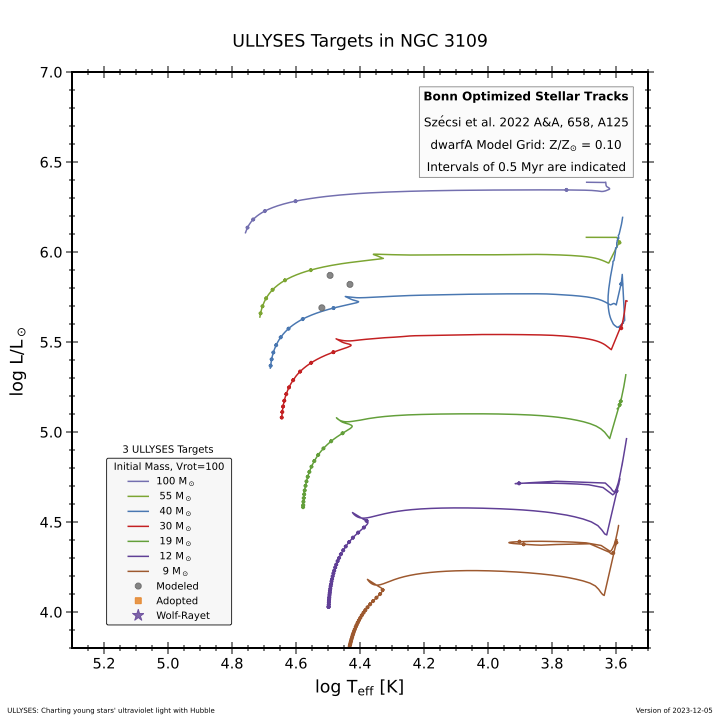
Figure 1: The figure above shows the distribution of stars in the ULLYSES sample in the Hertzsprung-Russell diagram for the galaxy NGC 3109. Values of the effective temperature (Teff) and luminosity (L) determined by model atmosphere analyses are used whenever possible. Otherwise, values of these parameters are adopted from the spectral-type calibration of Doran et al. (2013, A&A, 558, A134). The parameters of the primary star are plotted for stars known to be in binary systems.
Fiducial evolutionary tracks from the model grid published by Szécsi et al. (2022, A&A, 658, A125) are also shown for a range of initial masses. These models were computed for single stars with a metallicity of Z/Z⊙=0.10. Time steps corresponding to 0.5 million years are highlighted along individual tracks, and five dashed lines trace isochrones for intervals of 1 - 5 million years (from left to right).
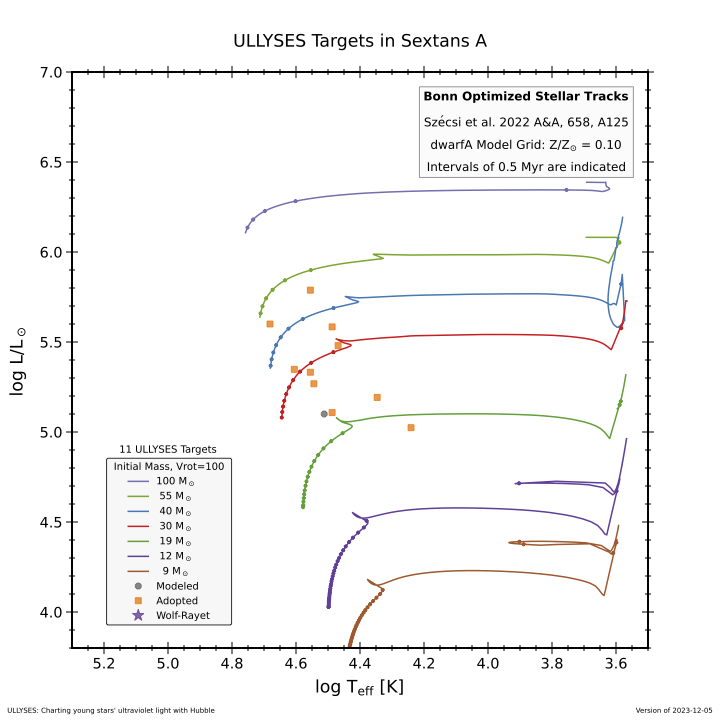
Figure 2: The figure above shows the distribution of stars in the ULLYSES sample in the Hertzsprung-Russell diagram for the galaxy Sextans A. Values of the effective temperature (Teff) and luminosity (L) determined by model atmosphere analyses are used whenever possible. Otherwise, values of these parameters are adopted from the spectral-type calibration of Doran et al. (2013, A&A, 558, A134). The parameters of the primary star are plotted for stars known to be in binary systems.
Fiducial evolutionary tracks from the model grid published by Szécsi et al. (2022, A&A, 658, A125) are also shown for a range of initial masses. These models were computed for single stars with a metallicity of Z/Z⊙=0.10. Time steps corresponding to 0.5 million years are highlighted along individual tracks, and five dashed lines trace isochrones for intervals of 1 - 5 million years (from left to right).
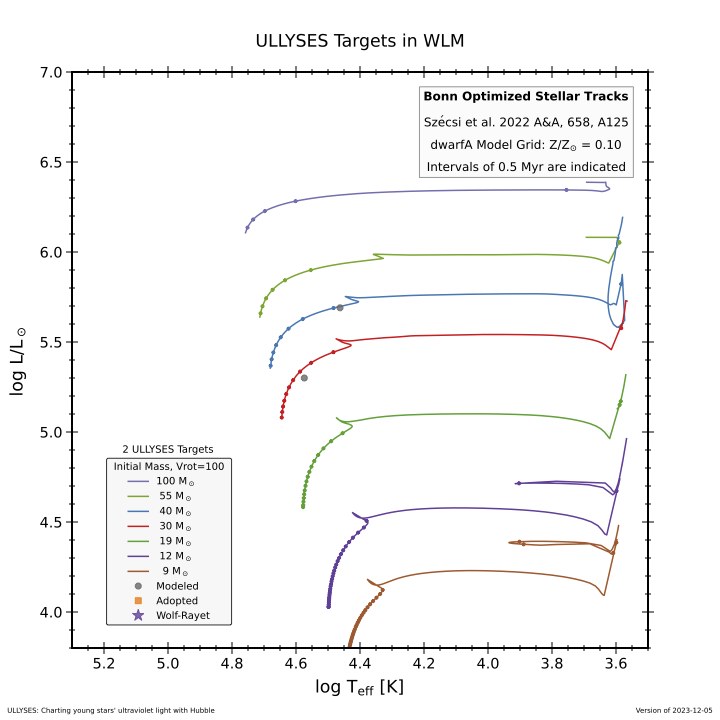
Figure 3: The figure above shows the distribution of stars in the ULLYSES sample in the Hertzsprung-Russell diagram for the galaxy WLM. Values of the effective temperature (Teff) and luminosity (L) determined by model atmosphere analyses are used whenever possible. Otherwise, values of these parameters are adopted from the spectral-type calibration of Doran et al. (2013, A&A, 558, A134). The parameters of the primary star are plotted for stars known to be in binary systems.
Fiducial evolutionary tracks from the model grid published by Szécsi et al. (2022, A&A, 658, A125) are also shown for a range of initial masses. These models were computed for single stars with a metallicity of Z/Z⊙=0.10. Time steps corresponding to 0.5 million years are highlighted along individual tracks, and five dashed lines trace isochrones for intervals of 1 - 5 million years (from left to right).
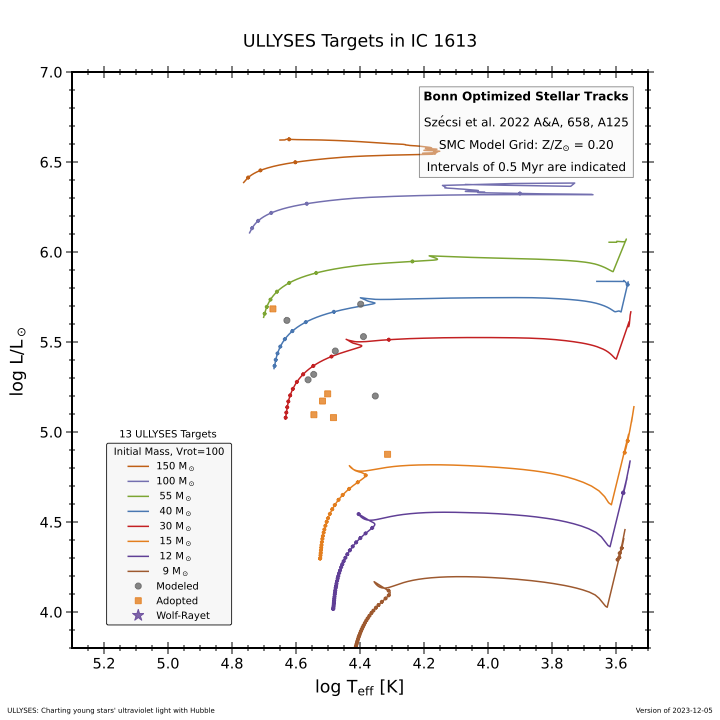
Figure 4: The figure above shows the distribution of stars in the ULLYSES sample in the Hertzsprung-Russell diagram for the galaxy IC 1613. Values of the effective temperature (Teff) and luminosity (L) determined by model atmosphere analyses are used whenever possible. Otherwise, values of these parameters are adopted from the spectral-type calibration of Doran et al. (2013, A&A, 558, A134). The parameters of the primary star are plotted for stars known to be in binary systems.
Fiducial evolutionary tracks from the model grid published by Szécsi et al. (2022, A&A, 658, A125) are also shown for a range of initial masses. These models were computed for single stars with a metallicity of Z/Z⊙=0.20. Time steps corresponding to 0.5 million years are highlighted along individual tracks, and five dashed lines trace isochrones for intervals of 1 - 5 million years (from left to right).
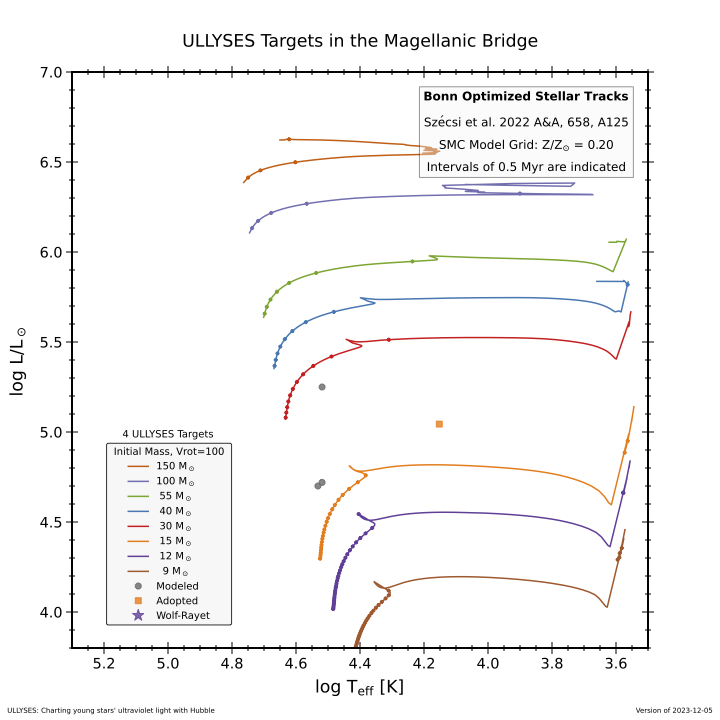
Figure 5: The figure above shows the distribution of stars in the ULLYSES sample in the Hertzsprung-Russell diagram for the Magellanic Bridge. Values of the effective temperature (Teff) and luminosity (L) determined by model atmosphere analyses are used whenever possible. Otherwise, values of these parameters are adopted from the spectral-type calibration of Doran et al. (2013, A&A, 558, A134). The parameters of the primary star are plotted for stars known to be in binary systems.
Fiducial evolutionary tracks from the model grid published by Szécsi et al. (2022, A&A, 658, A125) are also shown for a range of initial masses. These models were computed for single stars with a metallicity of Z/Z⊙=0.20. Time steps corresponding to 0.5 million years are highlighted along individual tracks, and five dashed lines trace isochrones for intervals of 1 - 5 million years (from left to right).
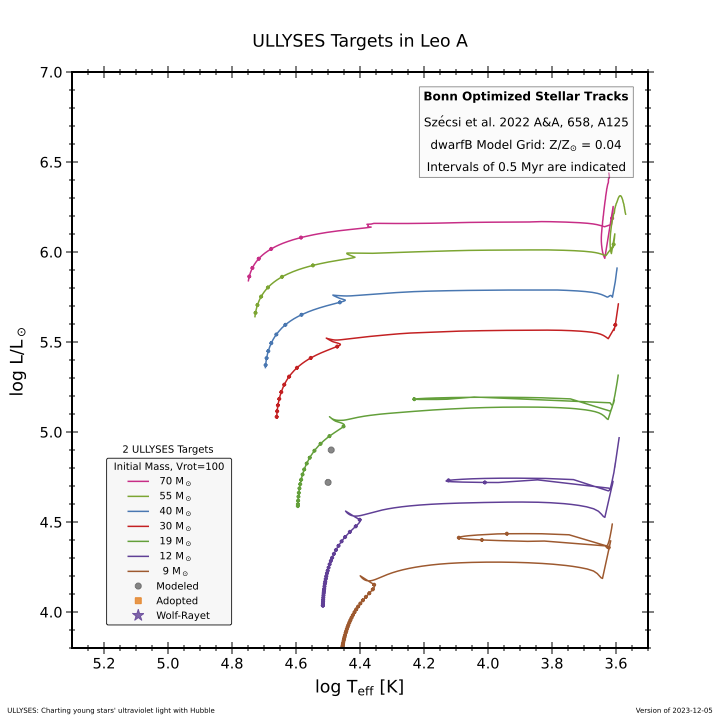
Figure 6: The figure above shows the distribution of stars in the ULLYSES sample in the Hertzsprung-Russell diagram for the galaxy Leo A. Values of the effective temperature (Teff) and luminosity (L) determined by model atmosphere analyses are used whenever possible. Otherwise, values of these parameters are adopted from the spectral-type calibration of Doran et al. (2013, A&A, 558, A134). The parameters of the primary star are plotted for stars known to be in binary systems.
Fiducial evolutionary tracks from the model grid published by Szécsi et al. (2022, A&A, 658, A125) are also shown for a range of initial masses. These models were computed for single stars with a metallicity of Z/Z⊙=0.04. Time steps corresponding to 0.5 million years are highlighted along individual tracks, and five dashed lines trace isochrones for intervals of 1 - 5 million years (from left to right).
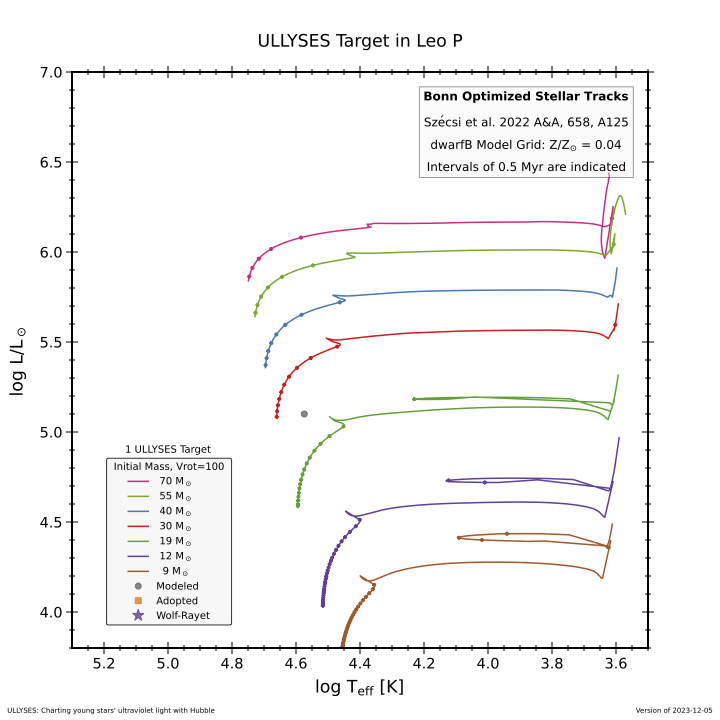
Figure 7: The figure above shows the distribution of stars in the ULLYSES sample in the Hertzsprung-Russell diagram for the galaxy Leo P. Values of the effective temperature (Teff) and luminosity (L) determined by model atmosphere analyses are used whenever possible. Otherwise, values of these parameters are adopted from the spectral-type calibration of Doran et al. (2013, A&A, 558, A134). The parameters of the primary star are plotted for stars known to be in binary systems.
Fiducial evolutionary tracks from the model grid published by Szécsi et al. (2022, A&A, 658, A125) are also shown for a range of initial masses. These models were computed for single stars with a metallicity of Z/Z⊙=0.04. Time steps corresponding to 0.5 million years are highlighted along individual tracks, and five dashed lines trace isochrones for intervals of 1 - 5 million years (from left to right).

